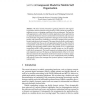Free Online Productivity Tools
i2Speak
i2Symbol
i2OCR
iTex2Img
iWeb2Print
iWeb2Shot
i2Type
iPdf2Split
iPdf2Merge
i2Bopomofo
i2Arabic
i2Style
i2Image
i2PDF
iLatex2Rtf
Sci2ools
COOPIS
2004
IEEE
2004
IEEE
Satin: A Component Model for Mobile Self Organisation
Abstract. We have recently witnessed a growing interest in self organising systems, both in research and in practice. These systems re-organise in response to new or changing conditions in the environment. The need for self organisation is often found in mobile applications; these applications are typically hosted in resource-constrained environments and may have to dynamically reorganise in response to changes of user needs, to heterogeneity and connectivity challenges, as well as to changes in the execution context and physical environment. We argue that physically mobile applications benefit from the use of self organisation primitives. We show that a component model that incorporates code mobility primitives assists in building self organising mobile systems. We present SATIN, a lightweight component model, which represents a mobile system as a set of interoperable local components. The model supports reconfiguration, by offering code migration services. We discuss an implementatio...
| Added | 20 Aug 2010 |
| Updated | 20 Aug 2010 |
| Type | Conference |
| Year | 2004 |
| Where | COOPIS |
| Authors | Stefanos Zachariadis, Cecilia Mascolo, Wolfgang Emmerich |
Comments (0)

